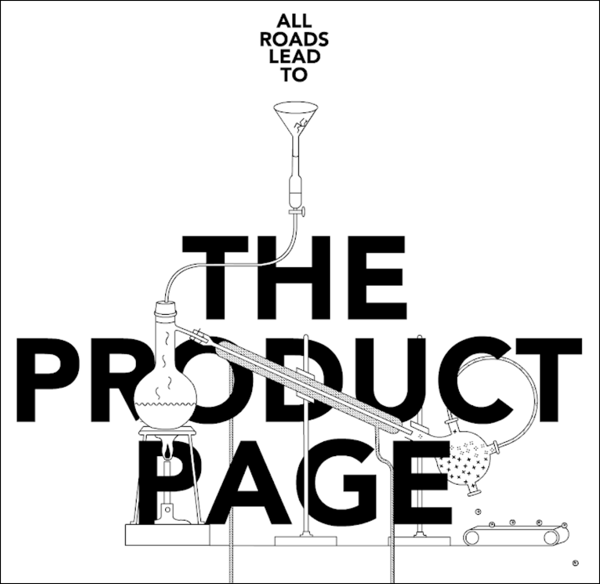Product Page Optimization: The Forgotten Tool in Ecommerce Sales
The most important and probably the least focused page on your website is the product page. This is where the “moment of truth” happens.
What is the “Moment of Truth?”
A visitor on a product page is telling us what they’re most intrigued by. Just check the time customers have spent on the product page vs. the rest of your website.
They’re looking to buy an item. How they react to this product page is the “moment of truth.”

Rethinking Product Pages
Typically, marketers have been selling products on ecommerce by talking about things like features and benefits, current price specials, glowing reviews, product photos, etc.
The problem with this one-time approach is that it does not adapt to the changing needs of the customers. If you were selling this product in person, would you keep using the same sales pitch over and over again? Or would you keep personalizing and improving it for each potential customer?
A Different Take on Product Page Optimization
Regardless of how a visitor gets to the product page, there are only 2 kinds of “moments of truth” that can occur:
- I’m ready to purchase now.
- Let me sleep on it.
As a marketer, I am more concerned about optimizing Instance #2. If a visitor chooses to ‘sleep on it’, there’s a 68% chance I’ve already lost them. This will have the most impact on my product page optimization.
What’s the Solution?
To realize the full potential of product page optimization we must understand the power of product stories.
Every product has a story to tell. There are two aspects to this story:
- “Why we (the brand) exist.”
- “Why this product must exist.”
Your website is a hurdle race. A shopper will be ready to use their credit card only after they’ve overcome their hurdles. A product story helps you overcome these

Image Credit: Photo by Interactive Sports on Unsplash
Hurdle No. 1: Who are you? Why should I care?
The “why we exist” part of the product story helps the site visitor overcome the hump of unfamiliarity with your brand.
KoMarketing did a survey where they asked “Once you’re on the homepage, what information do you want to see available?” 52% said About / Company Information.
Hurdle No. 2: I like you. I understand why you exist. What makes your product the right choice for me?
The “why this product must exist” part of the product story helps the site visitor stick to your product instead of going after alternatives.
We’ve seen a 20% sales bump on product pages we’ve tested using these two sections.
How to extract these stories?
What happens when I tell you a funny joke once?
Twice?
Thrice?
Twenty times?
Everyday for the next 3 years?
This is what happens to our clients: they’ve heard their business’ and products’ story so many times, that it isn’t novel for them anymore. But it will be for their customers! So we devised a role-play exercise to help our clients overcome their natural hesitation and extract the product story from them.
Fill in the Blanks:
You are sitting at an upscale bar enjoying a delicious cocktail. It’s been a good week.
Someone sits next to you. You get talking and hit it off. You tell them about your business. They smile and lean in with interest.
Turns out, they’ve been looking for __________. This is a crazy moment of serendipity.
They’ve visited plenty of online review sites and seen plenty of products, but just haven’t found the right model. If anything, there are too many options out there, and now are paralyzed by choice.
They ask, “Mind if I play around on your site on my phone right now?”
You say, “Absolutely!”
20 minutes later, they are ready with questions:
— When did you first see the need?
Your reply: __________________________________________________
— Why did it affect you? What personal frustration did it connect with?
Your reply: __________________________________________________
— Were you surprised the product didn’t already exist?
Your reply: __________________________________________________
— How did you go from having the idea to mustering the courage to start a company? Was that scary?
Your reply: __________________________________________________
— Running a business is hard as hell. How did you overcome setbacks along the way? What gets you out of bed every day?
Your reply: __________________________________________________
— What are your guiding principles?
Your reply: __________________________________________________
— How do stay ahead of competitors with deeper pockets?
Your reply: __________________________________________________
— Before you started what options were available to the shopper?
Your reply: __________________________________________________
— What was the most complicated part of the _______ (product name) development process? Were there parts that turned out to be way more complicated than you had originally anticipated?
Your reply: __________________________________________________
— How important is it that this product exists? What would the world miss out on if it didn’t exist?
Your reply: __________________________________________________
— How do you stay ahead of the competition?
Your reply: __________________________________________________
— Your invention has been available for the last ___ years. What improvements have you made along the way? Please share some of those product improvement stories.
Your reply: __________________________________________________
— When you talk to customers who have bought and used __________ (product name), what feature do they seem most surprised by?
Your reply: __________________________________________________
— What is one aspect of your product story that most buyers don’t know?
Your reply: __________________________________________________
— Sites like __________ and _________ can outspend you online. They will always show up #1 in a Google search. How do you plan to deal with that?
Your reply: __________________________________________________
These are the most common questions we ask. We expand this list for each client we work with.
Self Obsessed Vs. Self Aware Product Page Optimization
Traditional marketing advice tells you to focus on the buyer instead of yourself. This advice is right.
You are doing your buyer’s a huge favor by helping them learn more about you. If you have a product that can improve the quality of their life, then it is your responsibility to help them understand it.
What this traditional advice actually means is that the product story should be from the perspective of the buyer, and not the seller. If you have to choose between no story and a self-obsessed story, I recommend the latter. While this story does its magic, you can work on reframing the perspective. But start.
I Have 10 Product Pages. Which One Should I Focus On?
Easy solution. List your product pages from most important to least important on the basis of which ones drive the most net profits. Start from No. 1 and No.2. Reinvest the results into optimizing the rest of the pages.
The secondary pages may not drive as much revenue as the Top 2, but they will drive more than their usual. It’s an easy and quick win.
What if your sales are divided between 50 odd items? Optimizing using this list won’t cut it.
For this situation, focus on the “why we exist” section of the product story. It’s easier because you don’t have to write it from the perspective of any one product. It is your origin story.
Test the story by placing a call-to-action button on your most visible pages. Call it “why we exist.” When a visitor clicks the buttons, all other instances of the button should get hidden on your website. We do not want to annoy people who’ve already clicked it.
Is That All?
Using these two aspects of product story to optimize your product page will give you a 3% bump in sales. If you want to see their full potential, then these stories must be shaped in a very specific way.
We use nine underused conversion copywriting tactics to shape these product stories. These tactics have been tested and validated across 200+ experiments in our 12 years of experience.
Once this is done, and we have converted a sizable percentage of our target, we focus on visitors who aren’t ready to buy today.
 Rishi Rawat
Rishi Rawat